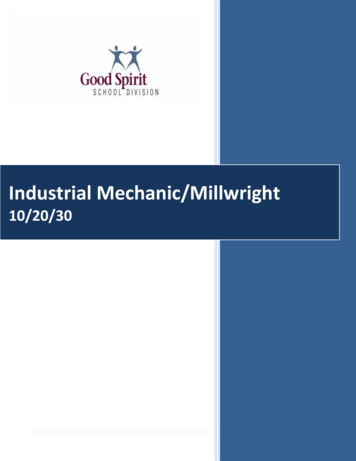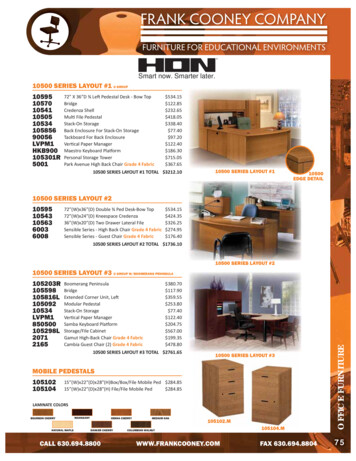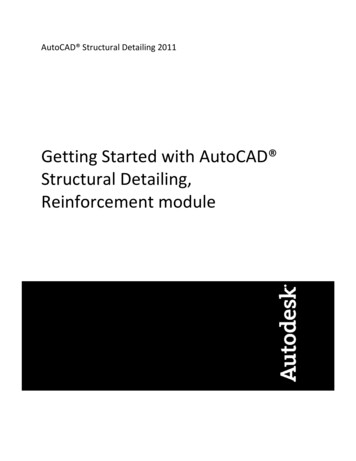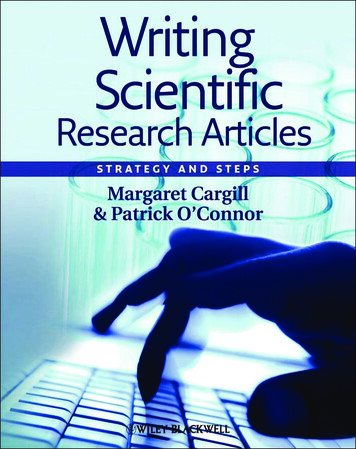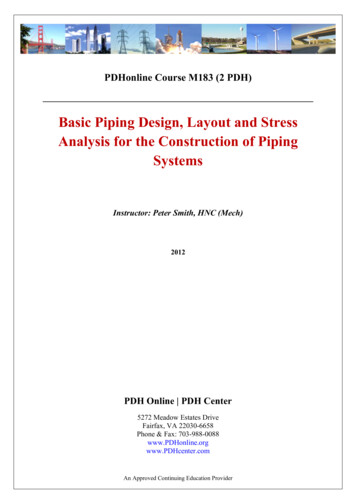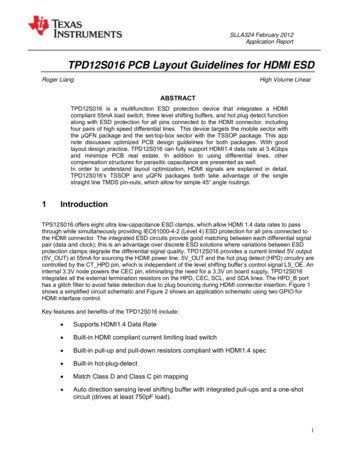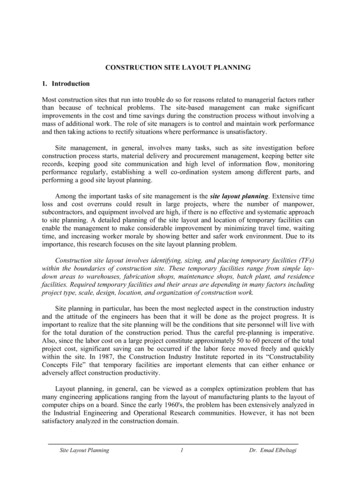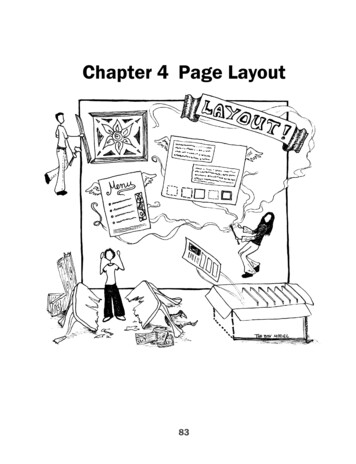
Transcription
THE NORTH CAROLINA STATE BARJOURNALFALL2016IN THIS ISSUECrowdfunding for Raising Capital page 10Retirement Planning page 20Legal Ethics and Social Media page 24
THENORTH CAROLINASTATE BARJOURNALFall 2016Volume 21, Number 3EditorJennifer R. DuncanPublications CommitteeDorothy Bernholz, ChairNancy Black Norelli, Vice-ChairJohn A. BowmanRichard G. BucknerAndrea CapuaThomas P. DavisMargaret H. DicksonJohn GehringJames W. HallDarrin JordanSonya C. McGrawHarold (Butch) PopeSteve RobertsonG. Gray Wilson Copyright 2016 by the North Carolina State Bar. Allrights reserved. Periodicals postage paid at Raleigh, NC,and additional offices. Opinions expressed by contributorsare not necessarily those of the North Carolina State Bar.POSTMASTER: Send address changes to the NorthCarolina State Bar, PO Box 25908, Raleigh, NC 27611.The North Carolina Bar Journal invites the submission ofunsolicited, original articles, essays, and book reviews.Submissions may be made by mail or e-mail (ncbar@bellsouth.net) to the editor. Publishing and editorial decisionsare based on the Publications Committee’s and the editor’sjudgment of the quality of the writing, the timeliness ofthe article, and the potential interest to the readers of theJournal. The Journal reserves the right to edit all manuscripts. The North Carolina State Bar Journal (ISSN10928626) is published four times per year in March,June, September, and December under the direction andsupervision of the council of the North Carolina State Bar,PO Box 25908, Raleigh, NC 27611. Member rate of 6.00 per year is included in dues. Nonmember rates 10.78 per year. Single copies 3.21. The Lawyer’sHandbook 10.78. Advertising rates available uponrequest. Direct inquiries to Director of Communications,the North Carolina State Bar, PO Box 25908, Raleigh,North Carolina 27611, tel. (919) 828-4620.ncbar.govFollow us at:Twitter: @NCStateBarFacebook: facebook.com/NCStateBarFE AT U R E S10 Crowdfunding for Raising Capitalhas ArrivedBy Thomas Lee Hazen14 The District Court at 50By James C. Drennan20 Retirement Planning and theTransitioning LawyersCommissionBy Woody Connette and Mark Scruggs24 Legal Ethics and Social MediaBy Chris McLaughlin27 New Rules for PermanentRelinquishment of State BarMembershipBy Eric M. Fink28 BarCARES and LAP—Workingin HarmonyBy Zeb Barnhardt and Robynn Moraites29 The Robin Williams in Each of UsBy Ronnie Ansley30 Fulfillment through Pro BonoPublico—An Interview withCarole BruceBy Eric M. Fink32 Special Education Team ImpactsSystemBy Elaine Whitford35 New Statewide Pro BonoResource Center LaunchedBy Jared Smith36 Voter Education is the Key toJudicial ElectionsBy Charles E. Raynal IVT H E N O RT H C A RO L I N A S TAT E B A R J O U R N A L3
404243D E PA RT M E N TS44563839President’s MessageState Bar OutlookLegal EthicsProfile in Specialization454647The Disciplinary DepartmentParalegal CertificationLawyer Assistance ProgramIOLTA UpdateTrust AccountingProposed Ethics OpinionsRule AmendmentsB A R4950525354U P D AT E SWilson Nominated asVice-PresidentClient Security FundLaw School BriefsIn MemoriamDistinguished Service AwardOfficersMargaret M. Hunt, Brevard - President 2015-2016Mark W. Merritt, Charlotte - President-Elect 2015-2016John M. Silverstein, Raleigh - Vice-President 2015-2016L. Thomas Lunsford II, Raleigh - Secretary-TreasurerRonald L. Gibson, Charlotte - Past-President 2015-2016CouncilorsBy Judicial District1:C. Everett Thompson II, Elizabeth City2:G. Thomas Davis Jr., Swan Quarter3A:Charles R. Hardee, Greenville3B:Debra L. Massie, Beaufort4:Robert W. Detwiler, Jacksonville5:Harold L. Pollock, Burgaw6:W. Rob Lewis II, Ahoskie7:Randall B. Pridgen, Rocky Mount8:C. Branson Vickory III, Goldsboro9:Paul J. Stainback, Henderson9A:Alan S. Hicks, Roxboro10:Heidi C. Bloom, RaleighWalter E. Brock Jr., RaleighNicholas J. Dombalis II, RaleighTheodore C. Edwards II, RaleighKatherine Ann Frye, RaleighDonna R. Rascoe, RaleighWarren Savage, RaleighC. Colon Willoughby Jr., Raleigh11A:Eddie S. Winstead III, Sanford11B:Marcia H. Armstrong, Smithfield12:Lonnie M. Player Jr., Fayetteville13:Harold G. Pope, Whiteville14:John A. Bowman, DurhamWilliam S. Mills, Durham15A:Charles E. Davis, Mebane15B:Dorothy Bernholz, Chapel Hill16A:Terry R. Garner, Laurinburg16B:David F. Branch Jr., Lumberton16C:Richard Buckner, Rockingham17A:Matthew W. Smith, Eden17B:Thomas W. Anderson, Pilot Mountain18:Barbara R. Christy, GreensboroStephen E. Robertson, Greensboro18H:Richard S. Towers, High Point19A:James D. Foster, Concord19B:Clark R. Bell, Asheboro19C:Darrin D. Jordan, Salisbury19D:Richard Costanza, Southern Pines20A:John Webster, Albemarle20B:H. Ligon Bundy, Monroe21:Michael L. Robinson, Winston-SalemKevin G. Williams, Winston-Salem22A:Kimberly S. Taylor, Taylorsville22B:Roger S. Tripp, Lexington23:John S. Willardson, Wilkesboro24:Andrea N. Capua, Boone25:M. Alan LeCroy, Morganton26:27A:27B:28:29A:29B:30:David N. Allen, CharlotteRobert C. Bowers, CharlotteA. Todd Brown, CharlotteMark P. Henriques, CharlotteF. Fincher Jarrell, CharlotteDewitt McCarley, CharlotteNancy Black Norelli, CharlotteSonya Campbell McGraw, GastoniaRalph W. Meekins, ShelbyAnna Hamrick, AshevilleH. Russell Neighbors, MarionChristopher S. Stepp, HendersonvilleGerald R. Collins Jr., MurphyPublic MembersMargaret H. Dickson, FayettevillePaul L. Fulton Jr., Winston-SalemJames W. Hall, AhoskieStaffShannon Azzi, Receptionist/IOLTA Accounting Data Asst.Carmen H. Bannon, Deputy CounselKelly Beck, Compliance Coordinator, Membership/CLEJoy C. Belk, Asst. Dir. Paralegal CertificationKrista Bennett, Fee Dispute Facilitator, ACAPMichael D. Blan, Systems Analyst/ProgrammerPeter Bolac, Trust Account Compliance Counsel, LegislativeLiaisonElizabeth E. Bolton, ReceptionistLori Brooks, Admin. Asst., Office of CounselDelia M. Brown, Administrative Asst., LAPMaria J. Brown, Deputy CounselKrista E. Carlson, InvestigatorBecky B. Carroll, ParalegalJoseph D. Cerone, Office ManagerAlyssa M. Chen, Deputy CounselMargaret Cloutier, Senior Deputy CounselJoseph J. Commisso, Director of InvestigationsMartin F. Coolidge Jr., InvestigatorSusannah B. Cox, Deputy CounselLuella C. Crane, Director of ACAPJennifer R. Duncan, Director of CommunicationsA. Root Edmonson, Deputy CounselJustin Edmonson, Admin. Asst., Special Projects CoordinatorNicole Ellington, Eastern Clinical Coordinator, LAPMartha Fletcher, Payroll and Benefits AdministratorTowanda Garner, Piedmont Clinical Coordinator, LAPLanice Heidbrink, Exec. Asst., AdministrationJeffery Hill, Computer Systems AdministratorLeanor Hodge, Deputy CounselDebra P. Holland, Asst. Director, CLEMary L. Irvine, Access to Justice CoordinatorTammy Jackson, Membership DirectorKatherine Jean, Counsel and Assistant Executive Dir.David R. Johnson, Deputy CounselSharon Kelly, Events ManagerBarbara Kerr, ArchivistCathy D. Killian, Clinical Director and Western ClinicalCoordinator, LAPMelanie Kincaid, ParalegalSuzanne Lever, Asst. Ethics CounselJeffrey D. Lundgren, ParalegalL. Thomas Lunsford II, Executive DirectorEric H. Lyerly, Admin. Asst.Adam Maner, Professional Organization CoordinatorBeth McIntire, IT ManagerBeth McLamb, Payment Coordinator, MembershipNichole P. McLaughlin, Asst. Ethics Counsel, District BarLiaisonBarry S. McNeill, Deputy CounselDiane Melching, Admin. Asst., ACAPDottie K. Miani, Deputy Clerk of DHC/Asst. Facilities ManagerClaire U. Mills, Accounts Manager, IOLTAAlice Neece Mine, Asst. Executive Dir., Dir. of CLE,Specialization, & Paralegal CertificationRobynn E. Moraites, LAP DirectorGeorge Muench, InvestigatorDenise Mullen, Asst. Director of Legal SpecializationPat Murphy, Deputy CounselLoriann Nicolicchia, Accreditation Coordinator, CLEEmily Oakes, Attendance/Compliance Coordinator, CLEBrian P.D. Oten, Deputy CounselCarolyn S. Page, InvestigatorLisanne Palacios, Accounting ManagerAnne M. Parkin, Field AuditorHeather Pattle, Administrator, Office of CounselC. Fred Patton Jr., InvestigatorWondella Payne, ParalegalAaliyah Pierce, Compliance Coordinator, Paralegal CertificationAngel Pitts, Mail/Copy/Accounting ClerkJennifer Porter, Deputy CounselEvelyn M. Pursley, Executive Dir., IOLTASonja B. Puryear, Admin. Asst., InvestigationsJoan Renken, Admin. Asst., Office of CounselRandall C. Ross, InvestigatorWhit Ruark, InvestigatorSandra L. Saxton, Public Liaison, ACAPFern Gunn Simeon, Deputy CounselJaya Singh, Accounting Asst.Jennifer Slattery, ParalegalE. Michael Smith Jr., InvestigatorSusie Taylor, Admin. Asst./Special Projects Manager, LAPJudith Treadwell, Public Liaison, ACAPWayne C. Truax, InvestigatorJoshua T. Walthall, Deputy CounselA. Dawn Whaley, Admin. Asst., InvestigationsEdward R. White, InvestigatorBrittany A. Wilson, ParalegalMary D. Winstead, Deputy CounselChristiane Woods, Admin Asst., Investigations
T H EPRES I DE NT’SM ES SA GEChallengesBYMARG ARE TM. HUN TAs my term as State Bar president comes toa close, I want to briefly discuss severalissues—some of long standing and some arising more recently—that have the potential tosignificantly reshape our profession for thefuture. The following are some of those issues:1. Public’s View of the Profession—Thepublic has a generally unfavorable view of thelegal profession with a majority believing thatlawyers primarily regulate theprofession for their own protection and act in their ownself-interest rather than in theinterest of clients and thepublic. Unfortunately, thepublic fails to understand theessential role of lawyers in thepreservation of the rule of lawand the administration of justice, which has been entrustedto each new generation oflawyers since the beginning ofour country. We advise andrepresent our clients, mitigate, challenge overreach by the government and other entities,and advocate for unpopular causes. We alsooffer ourselves for public office, serve on government boards and commissions, on nonprofit and community boards where our skillsand expertise are indispensable, and regularlyprovide legal services pro bono either throughorganizations or individually on an ad hocbasis. Our profession has been absolutely integral to the creation and the preservation of ourform of government, to the development of afree market economy, and to a free and civilsociety. We have a great story to tell, but weleft the playing field a long time ago, and others have written our story for us to the detriment of our profession and the public’s perception of us.The rule of law will survive only as long asthe public has confidence in its administration. It is evident that the public is losing confidence, and I believe this misperception ofour profession is one of the most significantproblems we face. This lack of good willT H E N O RT H C A RO L I N A S TAT E B A R J O U R N A Ltoward our profession makes it much moredifficult to garner support from the publicand legislators for the passage of legislationnecessary to properly regulate our professionand to regulate nonlawyer providers of legalservices in order to protect the public.2. Internet Providers of Legal Services —With the passage of House Bill 436 (theLegalZoom bill), many lawyers may thinkthat the issue of internetproviders has been resolved.While House Bill 436 provides a regulatory frameworkfor internet providers of legaldocuments, issues are likely toarise from other internetproviders who offer morethan legal documents, such asAVVO which advertises fixedfee services provided by “experienced lawyers” with “satisfaction guaranteed” in suchpractice areas as criminaldefense, family law, estate planning, bankruptcy, and real estate. In addition, someinternet providers are advancing from providing legal documents to providing automatedlegal advice through the use of artificial intelligence applications. When nonlawyers useartificial intelligence technology to give legaladvice based on a customer’s individual facts,most lawyers consider that the unauthorizedpractice of law. How will that be regulated inthe future?3. The Uniform Bar Examination—TheUniform Bar Examination (UBE) has nowbeen adopted by over 20 states. Each statethat adopts the UBE selects its own passingscore, may add a state specific test component, and will continue to conduct its owncharacter and fitness vetting. The UBE resultsin a portable score and portable law licensethat can be transferred to other UBE jurisdictions if the applicant’s character and fitness issuccessfully vetted. The American BarAssociation’s House of Delegates voted tosupport the Uniform Bar Examination, andthe North Carolina Board of Law Examinersis now studying the issue.4. Alternative Business Structures—Thissubject is currently under study by theAmerican Bar Association’s Commission onthe Future of Legal Services. One modelunder study allows nonlawyers to own equityinterests in a law firm. Variations of thismodel would allow nonlawyer owners toactively participate in the operations of thelaw firm, and another alternative would prohibit the nonlawyer investor from any activerole in the operations of the law firm.Another variation allows a percentage of ownership by a nonlawyer, anywhere from aminority interest to an unlimited share.Legislation that would permit nonlawyerownership interests in North Carolina lawfirms was introduced in the GeneralAssembly several years ago, but failed to pass.Washington, DC, allows nonlawyers toown equity interests in law firms, andWashington State allows their licensed legaltechnicians to have an equity interest in lawfirms in that state.Such an arrangement, in addition to obvious conflicts issues, could interfere with alawyer’s ability to adhere to some of our corevalues such as undivided loyalty to clients andgiving clients our best independent legaljudgment and advice.5. Legal Technicians—Some states arestudying whether to adopt a certificationprocess that would permit nonlawyers toperform certain specific legal services nowconsidered to be the practice of law.Washington State has adopted such a program and it is currently limited to certainclearly defined family law matters. This issueis also being studied by the Commission onthe Future of Legal Services. Both certification or licensing of legal technicians andnonlawyer internet providers of legal documents are believed by some to make basiclegal services more accessible to those whoCONTINUED ON PAGE 235
S T A TEBAROUTLOOKThe Micawber PrincipleBY L. TH O MASLUN S F OR DIIIn managing the State Bar’s finances, I amever mindful of the economic philosophy ofWilkins Micawber, the impecunious landlordand mentor of David Copperfield, whomyou will no doubt recall from tenth gradeEnglish. One of Charles Dickens’ greatestcomic creations, Mr. Micawber was evidentlymodeled upon the author’s father, an incurable optimist whose knack for fiscal ruin ledinevitably to debtor’s prison.Micawber’s personal economy was a curious admixtureof faith and rueful calculation. On the income side ofhis personal equation,Micawber was merely sanguine. He trusted simply andperennially that, “somethingwill turn up.” Unfortunately,he was generally unfortunate.Where expenses were concerned,however,Mr.Micawber was actually wise,but slavishly imprudent. He understood thecurse of insolvency, but couldn’t resist it.Perhaps you will recall his definitive pronouncement on the subject:Annual income 20 pounds, annual expenditure 19 (pounds), 19 (shillings), and six(pence), result happiness. Annual income 20pounds, annual expenditure 20 poundsought and six, result misery.This quotation, known widely as theembodiment of the Micawber Principle, provides a bit of cheerful context for this essayconcerning how the State Bar spends andwhy. Faithful readers of this column will recallthat the matter of revenue was discussed thelast time I appeared in these pages. As wasthen noted, our income streams are reasonably well understood, fairly reliable, andpresently adequate. Although it is always nicewhen something unexpected “turns up,” we,unlike Mr. Micawber, aren’t having to counton that to make ends meet. We are, as it happens, more heedful of his advice and experience where expenditures are concerned.6Indeed, we have embraced his prescriptionfor happiness wholeheartedly in the StateBar’s operational budget for 2016, projectinga surplus of nearly 140,000.My purpose herein is to describe thespending decisions that collectively ought toenable us to balance the budget this year—and to avoid prison and the necessity of starting over in Australia, like Mr. Micawber. Inthe service of these nobleobjectives, I am again offeringfor your enlightenment a couple of multi-colored piecharts. Like most pastries ofthe sort, the first categoricallydepicts the relative amountsof spending that are requiredto administer the agency. Forease of understanding, a greatmany related accounts arebeing combined under broadheadings like “personnelexpenses,” “building expenses” and “office expenses.” For those of youwho are inclined to “drill down” into the figurative crust, I will also try to create vivid “wordpictures” concerning our outlays for especiallyintriguing line items like “salaries” and “utilities.” The second pie chart presents some ofthe same information in a somewhat differentway. It displays our relative costs for particularundertakings such as the disciplinary program, the ethics program, and the LawyerAssistance Program. Admittedly, this is a lot totake in, and reader discretion is advised.The operational budget for 2016 contemplates expenditures totaling 9,183,977. Ofthat amount, more than 63% ( 5,835,347 tobe exact) has been appropriated to pay “personnel expenses.” Most of that money is, notsurprisingly, devoted to the payment of“salaries.”1 This year the amount budgetedfor that line item totals 4,447,205, a figurethat incorporates an across the board increasein compensation for our dedicated employeesof about 2%. Benefits, including healthinsurance, dental insurance, life insurance,FICA, parking, coffee, and participation in aTHE NORTH CAROLINA STATE BARCATEGORIES OF EXPENSES2016 11%16%Council & Committee 8%Personnel Trial Expenses1%Office ExpensesBuilding Expenses64%FALL 2016
defined contribution pension plan, areexpected to cost the State Bar an additional 1,258,667, more or less. It is rather difficultto predict with total confidence how muchand how quickly the staff and its compensation are likely to grow over the next few years.We do know that the need for additional personnel increases as a function of membershipgrowth, which has been rising at around2.5% a year. If recent experience is any guide,it seems clear that more and more people aregoing to be required to investigate and prosecute disciplinary cases that are becoming evermore complex, numerous, and protracted. Incontrast, we hope to need fewer administrative workers. As we are able to leverage digitaltechnologies more effectively to eliminatepaper transactions, we ought to be in a position to do more with the same or fewer people. The savings from foregone coffee aloneshould be quite hefty.The next largest slice of administrative pieis less filling but tastes great. I am referring, ofcourse, to the wedge encaptioned “counciland committee expenses.” That category,which embraces a fairly wide variety ofaccounts, is expected to total 1,459,324 in2016, or about 16% of our budgetedexpense. As you may be aware, the council isthe State Bar’s governing board. It is composed of 68 members: 61 lawyers electedfrom the 45 judicial districts, three publicmembers appointed by the governor, andfour officers elected by the councilors.Although most business school textbookswould caution against governance by threescore and eight, the council, which acts mainly through its various committees, has provenover time to be rather nimble, wise, and effective. It is also expensive to operate. The council meets quarterly for at least three days at atime, most often in Raleigh. Because its volunteer members are drawn from all over thestate, there is considerable cost associatedwith their participation, about 320,000 inthe current year. It is believed that theseexpenses should remain fairly predictable andstable going forward—unless the GeneralAssembly creates more judicial districts. Sinceevery district is entitled by law to its owncouncilor, the size of our board increasesautomatically whenever the legislaturedecides to create a new prosecutorial district,and is theoretically unlimited.2Also gathered under this heading are thecosts of sending our officers and senior staff toprofessional meetings inside and outside ofT H E N O RT H C A RO L I N A S TAT E B A R J O U R N A LNorth Carolina. Although the dollarsinvolved are not large, it is worth noting thatin recent years, the cost of intrastate travel hasrisen sharply, largely because our presidentshave been remarkably energetic in makingthemselves available in-person whenever andwherever lawyers have been gathering. Sincetwo of the last three presidents have beenbased in Kitty Hawk and Brevard, their faithfulness and ubiquity have been both impressive and costly. Thank goodness we reimburseonly for food, lodging, and mileage.3 We alsosupport several delegates to the American BarAssociation’s House of Delegates, and weannually sponsor four district bar meetings infour widely dispersed areas. All told, the costof taking our act and our people on the roadis expected to exceed 110,000 this year.But wait, that’s not all. Several oddaccounts are lumped in with “council andcommittee expenses” because they don’t seemto fit anywhere else. The most significant itemis the cost of supporting the LawyerAssistance Program (LAP), 744,376 to beprecise. As everyone should know by now, theLAP through its highly trained staff andlegions of dedicated volunteers, identifieslawyers who are impaired by substance abuseand mental illness and assists them in gettingtreatment. The LAP Board, like the State Bar’sother quasi-independent boards, is regardedas a standing committee of the council.Unlike the other boards, however, it is without its own source of revenue and is necessarily carried as an expense account in the StateBar’s budget. The size of the appropriation,which is inclusive of all costs associated withthe undertaking, is indicative of the importance of the program, the risk to the publicassociated with impairment, and the Bar’scommitment to helping suffering lawyers.Like the size of the council and the number ofmiles our presidents drive in support of theBar, the justifiable cost of running the LAPmight very well be unlimited. The demandfor its services is, after all, seemingly inexhaustible. Nevertheless, it appears to me thatthe State Bar’s financial support for the program is at an appropriate level, and is unlikelyto increase dramatically in the near term.Although the State Bar’s Office of Counselis one of North Carolina’s best law firms, weare still finding it necessary to spend seriousmoney on private attorneys. In 2016 we havebudgeted 200,000 for that purpose, moneywhich is also accounted for under the rubric of“council and committee expenses.” That isactually less than half of what we spent on outside counsel in 2015, a year in which we contended mightily with the LegalZoom corporation concerning the application of theSherman Act. The fact that we are finding itnecessary to hire private counsel is no knockon our own lawyers. They are all extremelycapable and are well-led by our general counsel, Katherine Jean. It is indicative mainly ofthe fact that the State Bar’s primary regulatoryresponsibility—the enforcement of our profession’s high ethical standards—requires thetime and energy of virtually all of our in-houselawyers almost all of the time. This circumstance, in combination with the reality thatanti-trust law is an arcane area of practice bestleft to specialists, has warranted our retentionof particularly qualified outside counsel.The amount budgeted for legal servicesthis year looks to be sufficient, based uponthe fees we have incurred through the first sixmonths. It is, however, impossible to say withconfidence what our costs for such serviceswill be going forward. Indeed, this categoryof expense is probably the biggest wild card inour entire financial deck. The agency hasbecome in recent years a “target of opportunity” for a great many disputatious folks.Fulfillment of the State Bar’s regulatory mission, especially its statutory obligation toenforce the laws prohibiting unauthorizedpractice, seems likely to engender muchfuture controversy and litigation. While theagency can call upon the attorney general forhighly qualified assistance under certain circumstances, and may have the contractualright to the provision of defense pursuant toits insurance policies in other situations, it isto our own treasury that we must often lookfor the resources necessary to ensure that theState Bar—and the people of NorthCarolina—are well represented.Although we can’t say for sure what it’sgoing to cost next year to defend the State Barin court, we do know exactly how much it’sgoing to take to stave off foreclosure. Asidefrom salaries, our biggest fixed cost is the service of our mortgage debt. And it’s most ofwhat we expect to spend in 2016 for “buildingexpenses.” Appropriations for the accountsgrouped under that broad heading—thingslike housekeeping, building maintenance, andutilities—total 1,048,966. Of that amount, 827,766 will be used to pay the mortgage.It’s a big chunk, to be sure, but is at least aknown quantity, fixed until the loan must berenegotiated in 2021. The other categories of7
“building expense” are fairly mundane, reasonably well understood, and not worth discussing. A couple of the accounts though—”LEED certification” and “building security”—do bear mentioning.The State Bar’s still new building wasdesigned to be energy efficient and “green.”To memorialize our good citizenship in thatregard, we resolved to seek LEED4 certification of the endeavor. We initially dreamed of“platinum” recognition, that being the “goldstandard” of sustainability. Regrettably, somethree years after the building’s completionand our receipt of the coveted “certificate ofoccupancy” from the City of Raleigh, ourmetallurgical aspirations were found to benonsustainable, and we were obliged to settlefor the “silver” award, which is from what Ican tell, the “bronze standard” for green or“greenish” buildings. Anyway, our budget for2016 includes 15,200 for LEED certification. The good news is that we have actuallyspent only 6,907 of that amount. The betternews is that we are now done with paying forLEED certification and can bask henceforthand forever5 in the warm afterglow of ourthird-place finish. Maybe we didn’t win, butwe did get on the podium, and no one cantake that away from us.We also expect to spend a fair amount ofmoney this year on enhanced security for ourbuilding and the people who use it. The sumof 12,500 has been earmarked for that purpose. Most of the funds will be used to hirearmed guards for duty at public disciplinaryproceedings conducted by the DisciplinaryHearing Commission. We don’t routinelymake such arrangements, but seem to beneeding the sobering presence of sworn peaceofficers more and more often lately as erraticbehavior among complainants and respondents increases. In any event, we haveeschewed, for the time being at least, the sortof intensive security measures that are nowcommonplace at courthouses throughout thestate, wanting the public to feel welcome tovisit our public building whenever they wish.We have chosen, instead, to heighten oursecurity on an ad hoc basis when circumstances seem to warrant extraordinary measures. Query whether it is better to inclinetoward hospitality or risk aversion in ourposition? I’m not sure I know the answer tothat question, but one thing is clear. It’sexpensive, and maybe impossible, to purchasereal safety in our business. And I’m not surewe can afford it.8I suspect that some of you are beginningto wonder whether this brutal exercise in fiscal transparency will ever be over. Perhapsyou’ve studied the first pie chart and nowrealize that there are still two major categories of expense yet to be discussed. If youfind this distressing, you are probably notalone. I believe it was Briscoe Darling, aphilosopher of some considerable reputationon the old Andy Griffith Show, who havingbeen memorably overserved by Aunt Beadeclared that, “three cuts of pie is my highwater mark.” If there are those of you whocan’t bear another scrap of information, nowwould be a good time to stop reading. Afterall, what can I say about “office expenses”that hasn’t already been said better by lots ofother people? My advice—just put the magazine down and back away from it slowly.No one will think less of you. But, if youthink you can handle it, I believe you’ll beglad if you “stay the course.”Speaking of “office expenses,” I ambound to confess that we expect to spend 738,340 on the items grouped under thatheading this year. That’s a lot of paperclips—and postage, and software licenses,and printing, and internet service, etc.Actually, there are 18 discrete line items constituting what are collectively described asoffice expenses in the State Bar’s operationalbudget. Not wanting to discourage the fewof you who have continued reading this essayagainst medical advice, I am choosing to discuss only a couple: “audit” and “website.”The State Bar is a state agency subject toreview by the state auditor. We are auditedannually by an independent accounting firmapproved by the state auditor. This year ourfiscal policies required us to change auditors.We budgeted 25,100 for the audit, butexpect to pay somewhat more for the serviceowing mainly to the auditors’ conclusion thatgenerally accepted accounting standardsrequire that the financial statements of theState Bar Council be consolidated with thoseof its several quasi-independent boards.6Heretofore, each board was subject to its owndiscrete audit and had its own entirely segregated fina
are not necessarily those of the North Carolina State Bar. POSTMASTER: Send address changes to the North Carolina State Bar, PO Box 25908, Raleigh, NC 27611. The North Carolina Bar Journalinvites the submission of unsolicited, original articles, essays, and book reviews. Submissions may be made by mail or e-mail (ncbar@bell-south.net) to the .
